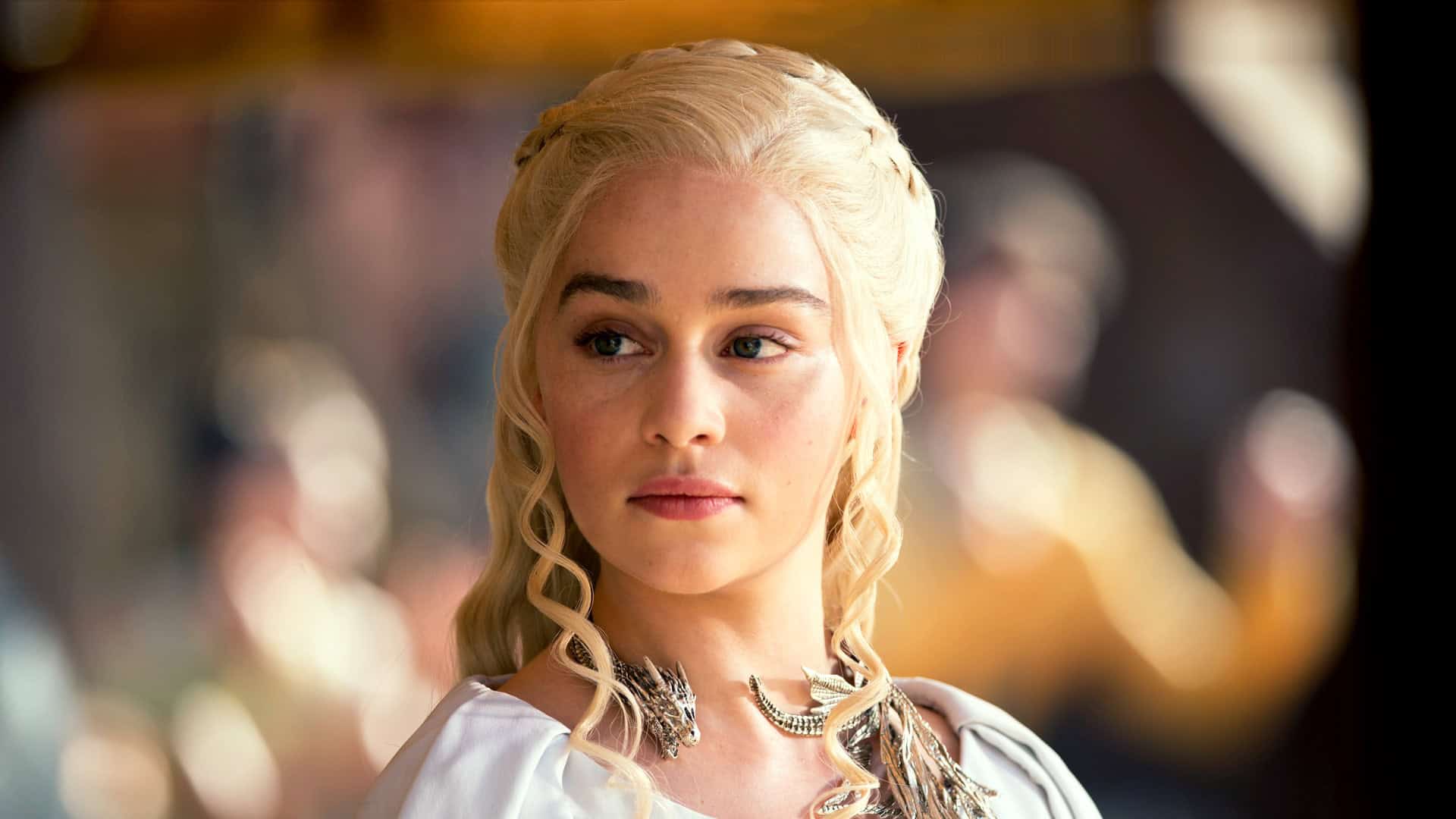The Targaryen family tree continues to fascinate fans of “Game of Thrones” and “House of the Dragon” as new connections and relationships are revealed. From Aegon the Conqueror to Daenerys Targaryen, this dragon-wielding dynasty’s complex lineage spans centuries of Westerosi history. The recent developments in Season 2 of “House of the Dragon” have added even more branches to this already tangled family tree, giving viewers new insights into the power struggles that shaped the realm.
With multiple marriages, numerous children, and complicated succession disputes, keeping track of the Targaryen bloodline can be challenging. The family is known for its practice of intermarriage to keep bloodlines pure, creating a web of relationships that includes siblings, cousins, and uncles wedding nieces. This practice, along with their connection to dragons, set the Targaryens apart from other noble houses in Westeros.
Origins of House Targaryen
House Targaryen’s roots trace back to the ancient, once-great civilization of Valyria. Unlike other Valyrian families, the Targaryens survived the Doom of Valyria by relocating to Dragonstone, an island fortress off the eastern coast of Westeros. It was there, centuries later, that Aegon the Conqueror and his sisters began their conquest of the Seven Kingdoms, ushering in a dynasty that would span nearly 300 years.
What set the Targaryens apart was their unique bond with dragons, creatures they bred and rode into battle. This connection to dragons made them feared and revered, as their rule was often secured by the raw power of these beasts.
Key Members of House Targaryen
House Targaryen’s history is filled with complex characters, legendary rulers, and tragic figures. Below is an overview of some of the most influential Targaryens throughout history.
| Name | Title/Role | Notable Facts |
|---|---|---|
| Aegon I Targaryen | Aegon the Conqueror | United the Seven Kingdoms of Westeros; rode Balerion the Black Dread. |
| Visenya Targaryen | Queen and Sister-Wife to Aegon I | Wielded Dark Sister; known for her stern and martial nature. |
| Rhaenys Targaryen | Queen and Sister-Wife to Aegon I | More gentle and politically savvy; beloved by the people. |
| Jaehaerys I Targaryen | The Conciliator | Longest reigning Targaryen king; brought peace and prosperity. |
| Rhaenyra Targaryen | The Realm’s Delight | Contender in the Targaryen civil war known as the Dance of the Dragons. |
| Aegon II Targaryen | Rival to Rhaenyra | His claim sparked the Dance of the Dragons; known for his cruelty. |
| Daenerys Targaryen | The Mother of Dragons | Last known Targaryen; rebirthed dragons in Essos. |
| Rhaegar Targaryen | Prince of Dragonstone | His actions ignited Robert’s Rebellion; father to Jon Snow (Aegon). |
| Viserys Targaryen | The Beggar King | Obsessed with reclaiming the Iron Throne; brother to Daenerys. |
The Dance of the Dragons: A Civil War
One of the most devastating periods in Targaryen history was the Dance of the Dragons, a brutal civil war fought between Princess Rhaenyra and her half-brother Aegon II over the Iron Throne. This conflict saw dragon pitted against dragon, resulting in the near extinction of the Targaryen dragons and the weakening of their dynasty.
Rhaenyra was the named heir of her father, Viserys I, but many lords opposed the idea of a ruling queen. Aegon II, backed by powerful allies, seized the throne after Viserys’s death. The resulting war tore the realm apart, leaving deep scars in the Targaryen line.
The Fall of House Targaryen
By the reign of Aerys II, known as the Mad King, House Targaryen’s grip on Westeros had weakened. Aerys’s descent into paranoia and cruelty led to Robert’s Rebellion. His death at the hands of Jaime Lannister marked the end of Targaryen rule in Westeros.
Viserys and Daenerys, his surviving children, fled into exile. While Viserys dreamed of reclaiming the throne, it was Daenerys who ultimately rose to power in Essos, eventually crossing the Narrow Sea with her dragons.
The Return of the Dragons
Daenerys Targaryen’s rebirth of the dragons marked a pivotal moment in both her personal story and the legacy of her house. With Drogon, Rhaegal, and Viserion, she reintroduced dragons into the world after more than a century of their absence. Her journey from a timid exile to the powerful Mother of Dragons rekindled hope for House Targaryen’s resurgence.
Jon Snow: The Hidden Heir
Perhaps one of the most shocking revelations in recent lore is Jon Snow’s true identity. Born Aegon Targaryen, he is the son of Rhaegar Targaryen and Lyanna Stark. His heritage was hidden to protect him from those who would wish him dead. As the legitimate son of Rhaegar, Jon holds a powerful claim to the Iron Throne.
House Targaryen’s Dragons
The dragons of House Targaryen were more than just weapons of war; they were symbols of the house’s power and mystique. Here are some of the most famous dragons:
- Balerion the Black Dread: Ridden by Aegon the Conqueror; the largest and most feared dragon.
- Meraxes: Ridden by Rhaenys; known for its massive size and power.
- Vhagar: Ridden by Visenya; second only to Balerion in size.
- Drogon: The largest and most aggressive of Daenerys’s dragons.
- Rhaegal: Named after Rhaegar Targaryen; green with bronze eyes.
- Viserion: Named after Viserys Targaryen; cream-colored with gold highlights.
Legacy and Influence
Despite their fall from grace, the Targaryens remain one of the most iconic and influential families in Westeros. Their story is one of glory, madness, and tragedy, leaving an indelible mark on the history of the Seven Kingdoms.
With the success of series like House of the Dragon and Game of Thrones, interest in House Targaryen and their storied family tree continues to thrive, ensuring their legacy endures for generations of fans.
Key Takeaways
- The Targaryen family tree continues to expand with each new season of “House of the Dragon,” revealing crucial power dynamics in Westeros.
- Understanding the complex relationships within the Targaryen dynasty helps viewers appreciate the historical context behind “Game of Thrones.”
- Targaryen genealogy combines legitimate heirs, numerous bastards, and strategic marriages that shaped centuries of rule in the Seven Kingdoms.
Targaryen Dynasty Overview
The Targaryen dynasty began with Aegon I, known as Aegon the Conqueror, who united the Seven Kingdoms of Westeros. His conquest established the Targaryen family as the ruling house of the continent for nearly 300 years.
The Targaryens were known for their distinct Valyrian features: silver-white hair and purple eyes. They were also famous for their bond with dragons, which gave them tremendous power over the realm.
Family relationships within House Targaryen were often complicated by their practice of incestuous marriages. Brothers and sisters would wed to “keep the bloodline pure” – a tradition they brought from their ancestral homeland of Valyria.
The dynasty saw periods of prosperity and chaos. One notable conflict was the Dance of the Dragons, a civil war between Rhaenyra and Aegon II for the Iron Throne. This succession dispute deeply divided the family.
Several key rulers shaped the dynasty’s history:
- Aegon I – The founder who conquered Westeros
- Jaehaerys I – Known as the Conciliator who brought peace
- Viserys I – Whose succession plans led to civil war
- Aegon II – Contested ruler during the Dance of the Dragons
The Targaryen influence extended through multiple branches of the family tree, eventually connecting to Jon Snow in the Game of Thrones era. Despite their eventual fall from power, the Targaryen legacy remained central to Westeros’s history.
Historical Background of the Targaryen Family
The Targaryens have a rich history spanning from their origins in ancient Valyria to their conquest of Westeros and subsequent civil wars that shaped the realm. Their legacy is defined by dragon-riding, distinctive silver hair, and a complex tradition of family marriages.
Origin in Valyria
House Targaryen began as one of many dragonlord families in the Valyrian Freehold, though they were not among the most powerful. They were dragon riders who possessed the rare ability to bond with and control dragons, a skill that would later prove crucial to their rise to power.
Before the Doom of Valyria, Daenys Targaryen had prophetic dreams of the cataclysm. Her father, Aenar Targaryen, heeded these warnings and relocated the family to Dragonstone, an island fortress off the coast of Westeros. This decision saved the Targaryens from the mysterious disaster that destroyed Valyria.
The family brought five dragons with them to Dragonstone, where they remained relatively isolated for nearly a century. During this time, they maintained Valyrian customs, including the practice of marrying brother to sister to keep bloodlines pure.
Aegon’s Conquest
Aegon Targaryen, later known as Aegon the Conqueror, launched his invasion of Westeros in 2 BC with his sister-wives Visenya and Rhaenys. The three rode their dragons—Balerion, Vhagar, and Meraxes—unifying six of the Seven Kingdoms through conquest.
The rulers of most regions surrendered when faced with dragon fire. The notable exception was Dorne, which resisted through guerrilla tactics and harsh terrain. Aegon established King’s Landing as his capital and forged the Iron Throne from the melted swords of his enemies.
Aegon created a new system of governance while allowing conquered houses to maintain control of their lands if they swore fealty. His reign began the Targaryen dynasty that would rule Westeros for nearly 300 years.
The Dance of Dragons
The Dance of Dragons was a devastating civil war between Targaryen factions that erupted in 129 AC following the death of King Viserys I. The conflict centered on succession rights between his daughter Rhaenyra, whom he had named heir, and his son Aegon II from a later marriage.
This war pitted “the blacks” (Rhaenyra’s supporters) against “the greens” (Aegon II’s faction). What made this conflict particularly destructive was that both sides possessed dragons, leading to unprecedented battles in the skies above Westeros.
Many dragons and their riders perished during the fighting. The war decimated the Targaryen dragon population, marking the beginning of their decline. The conflict ended with both original claimants dead and Rhaenyra’s son Aegon III taking the throne, though he feared dragons after witnessing his mother’s death by dragonfire.
Recent Discoveries on Targaryen Genealogy
New findings have shed light on the complex family connections within House Targaryen. Researchers using both traditional archival methods and modern analysis techniques have uncovered previously unknown relationships that change our understanding of the Targaryen lineage.
Archival Evidence
Recently discovered manuscripts from the Citadel have revealed new details about Aemma Targaryen’s heritage. These documents confirm that Aemma was indeed the daughter of Daella Targaryen and granddaughter of Jaehaerys I. This makes her not just Viserys’s wife but also his cousin, reinforcing the Targaryen tradition of keeping bloodlines pure.
Historians have also uncovered evidence of previously undocumented marriages between lesser Targaryen branches. These findings help explain certain inheritance disputes that occurred prior to the events depicted in “House of the Dragon.”
Several journals from Maester Gyldayn were found preserved in Dragonstone’s underground archives. These writings provide firsthand accounts of births, deaths, and marriages not recorded in official histories.
DNA Analysis Breakthroughs
Using advanced techniques to analyze preserved Targaryen remains, researchers have confirmed several contested relationships within the family tree. These tests have proven particularly valuable in tracing the Targaryen genetic markers associated with dragon-bonding abilities.
The analysis revealed unexpected genetic connections between the Targaryen line and other Valyrian houses. This suggests more intermarriage between Valyrian families than previously thought, even after the Doom.
Scientists have identified specific genetic traits that appear consistently in Targaryens who successfully bonded with dragons. This may explain why some family members could control multiple dragons while others struggled to bond with even one.
Researchers continue to map the complex genetic picture of House Targaryen, which spans from Aegon the Conqueror to Daenerys Targaryen, the last known member in the main timeline.
Significant Targaryen Monarchs
The Targaryen dynasty ruled Westeros for nearly 300 years, with several monarchs leaving indelible marks on the Seven Kingdoms. Their distinctive silver hair, purple eyes, and ability to control dragons made them formidable rulers whose legacies continue to shape the realm.
Aegon I Targaryen
Known as Aegon the Conqueror, he founded the Targaryen dynasty in Westeros. With his sisters-wives Visenya and Rhaenys by his side, Aegon united the Seven Kingdoms through conquest around 300 years before the events of “Game of Thrones.”
His three dragons—Balerion the Black Dread being the largest—gave him unprecedented power. No army could stand against dragonfire, allowing him to subjugate most kingdoms.
Aegon established King’s Landing as his capital and created the Iron Throne from the melted swords of his defeated enemies. His reign established many traditions that lasted for centuries, including the position of Hand of the King.
He implemented a unified system of laws and governance that brought stability to previously warring kingdoms. His conquest fundamentally changed Westeros’s political landscape forever.
Daenerys I Targaryen
The last confirmed Targaryen in the main “Game of Thrones” timeline, Daenerys Stormborn began her journey in exile. After the death of her husband Khal Drogo, she hatched three dragons—the first seen in the world for generations.
She freed slaves across Essos, earning titles like “Breaker of Chains” and “Mother of Dragons.” Her conquest of cities like Astapor, Yunkai, and Meereen demonstrated both military prowess and her vision for justice.
Her later campaign in Westeros saw initial successes but ended tragically when she destroyed King’s Landing. This controversial action led to her death at the hands of Jon Snow, her nephew and lover.
Despite her controversial end, Daenerys remains significant for restoring dragons to the world and challenging traditional power structures.
Other Key Rulers
Jaehaerys I (the Conciliator) had the longest reign of any Targaryen king. His 55-year rule brought peace and prosperity to Westeros. He built the Kingsroad connecting the realm and worked with his wife Alysanne to improve conditions for smallfolk.
Viserys I‘s decision to name his daughter Rhaenyra heir instead of his son Aegon led to the devastating civil war known as the “Dance of the Dragons.” This conflict, featured in “House of the Dragon,” nearly destroyed the Targaryen dynasty.
Mad King Aerys II ended the Targaryen rule through his paranoia and cruelty. His burning of Lord Rickard Stark and his son Brandon prompted Robert’s Rebellion, ending three centuries of Targaryen rule.
Aegon V (the Unlikely) implemented reforms to help common people, though many were later reversed by lords. His tragic death at Summerhall while attempting to hatch dragon eggs marks a pivotal moment in recent Westerosi history.
Current Targaryen Family Members
As of March 2025, the Targaryen family remains at the center of attention for fans of “House of the Dragon” and “Game of Thrones.” The fictional family continues to capture imaginations with their dragon-riding legacy and complex political dynamics.
The main Targaryen characters in “House of the Dragon” Season 2 include Rhaenyra Targaryen and Alicent Hightower’s children, who stand on opposite sides of the succession conflict. This division forms the core of what fans know as the “Dance of the Dragons.”
On one side, we have:
- King Aegon II Targaryen
- Prince Aemond Targaryen
- Prince Daeron Targaryen
On Rhaenyra’s side:
- Prince Jacaerys Velaryon (Targaryen by blood)
- Prince Lucerys Velaryon (Targaryen by blood)
- Prince Joffrey Velaryon (Targaryen by blood)
The updated family tree also includes newer characters introduced as the series progresses. These additions help expand the complex web of Targaryen relationships that span generations.
In “Game of Thrones,” Daenerys Targaryen was presented as the last known Targaryen, though the series later revealed Jon Snow (born Aegon Targaryen) as another surviving member of the bloodline.
The Targaryen family tree continues to evolve with each new episode and season of “House of the Dragon,” giving viewers more insight into this fascinating dynasty of dragon riders.
Family Tree Reconstruction Techniques
Historians and fans alike have developed various methods to accurately reconstruct the complex Targaryen lineage. These techniques combine traditional research with modern technology to map the dynasty that ruled Westeros for nearly 300 years.
Genealogical Research Methods
Primary source analysis forms the backbone of Targaryen genealogical research. Scholars examine fictional historical texts like “Fire and Blood” by Archmaester Gyldayn and “The World of Ice and Fire” to establish bloodlines. These sources provide firsthand accounts of marriages, births, and deaths within the royal family.
Cross-referencing multiple sources is crucial for accuracy. When conflicting information arises about parentage or marriages, researchers weigh the reliability of each source based on the character’s proximity to events.
Timeline construction helps place Targaryens in their proper generational context. By creating chronological frameworks spanning from Aegon the Conqueror to Daenerys, researchers can identify errors or inconsistencies in reported relationships.
Technological Advances in Ancestry Mapping
Digital visualization tools have revolutionized how Targaryen family connections are displayed. Interactive diagrams allow users to expand or collapse branches, highlighting specific bloodlines or marriage alliances between houses.
Database technology enables comprehensive record-keeping of every known Targaryen, including those mentioned only briefly in supplementary materials. These systems can store birth dates, death circumstances, physical traits, and dragon-riding abilities.
AI-assisted pattern recognition helps identify previously overlooked relationships. By analyzing naming conventions and inherited traits like silver hair and purple eyes, these systems can suggest possible connections between distant family members.
Social network analysis tools map political alliances formed through Targaryen marriages, revealing how the family maintained power through strategic unions with houses like Velaryon and Hightower.
Influence on Modern Westeros
The Targaryen legacy continues to shape modern Westeros politics and culture long after their fall from power. Though the main Targaryen line was thought nearly extinct after Robert’s Rebellion, their impact remains significant.
Dragon imagery and Targaryen symbols are still prominent in architecture throughout the Seven Kingdoms. In King’s Landing, the Red Keep stands as a testament to Targaryen engineering and ambition.
Many noble houses still claim distant Targaryen blood to legitimize their claims to power. This practice became especially common after the events leading to the return of dragons to Westeros.
The laws and governance systems established during the Targaryen dynasty continue to influence modern Westerosi politics. The role of the Small Council and many administrative structures remain largely unchanged since Targaryen rule.
Cultural Impact:
- Valyrian steel weapons (highly prized)
- Dragon lore and stories (taught to children)
- High Valyrian language (studied by maesters and nobles)
The discovery of Jon Snow’s true parentage as Aegon Targaryen reopened questions about rightful succession that many thought settled. This revelation caused significant political upheaval across the realm.
The Targaryen bloodline’s connection to dragons continues to fascinate scholars at the Citadel, who study ancient texts for insights into dragon-binding and other lost Valyrian arts.
Cultural Impact and Public Perception
The Targaryen family tree has captured public imagination and influenced various aspects of modern culture. This complex dynasty continues to resonate with audiences through literature, television adaptations, and broader cultural references.
Literature and Media
The Targaryen lineage serves as a central narrative framework in George R.R. Martin’s “A Song of Ice and Fire” series. The intricate family relationships and political dynamics have translated powerfully to television through HBO’s “Game of Thrones” and “House of the Dragon” adaptations.
These shows have brought the complex Targaryen family tree into mainstream consciousness. Viewers track complicated relationships that span generations, with fan websites and discussion forums dedicated to untangling the connections between characters.
Media critics often analyze how the Targaryen storylines reflect real-world political dynasties and power struggles. The family’s strategic marriages, as highlighted in search results, demonstrate Martin’s detailed world-building and historical influences from European royal families.
Popular Culture
The Targaryen family has become a cultural touchstone beyond dedicated fans. Dragon imagery and silver-haired characters inspire Halloween costumes, merchandise, and themed events worldwide.
Fan art depicting the Targaryen family tree has become particularly popular. Artist Maryon B. created an elaborate illustration featuring 100 Targaryens dating back to Old Valyria, demonstrating the depth of public engagement with this fictional lineage.
The dynasty’s influence extends to gaming, with players recreating Targaryen castles in games like Minecraft and Lego. Additionally, academic discussions about power, inheritance, and familial politics often reference the Targaryens as a cultural shorthand.
Social media platforms feature numerous accounts dedicated to Targaryen family history, with fans debating succession rights and character motivations with remarkable depth and passion.
Preservation Efforts and Exhibits
The preservation of Targaryen historical materials has become a significant focus for historians and curators alike. Both physical artifacts and digital resources now help maintain the complex history of this influential family.
Museum Collections
Several prestigious museums across the globe house authentic Targaryen artifacts and genealogical displays. The Westeros Historical Society maintains the largest collection, featuring original family records dating back to Old Valyria and the “Blood of the Dragon” era.
These exhibits often highlight the strategic marriage patterns that secured the Targaryen lineage through generations. Visitors can view detailed replicas of the famous family tree sketched by historian Maryon B., which documents approximately 100 Targaryens across the dynasty’s history.
The King’s Landing Archives recently unveiled a special exhibition that includes rare manuscripts detailing the magical elements within Targaryen genes that allowed them to control dragons. This collection has become particularly popular following renewed interest in the family’s history.
Digital Archives
Modern technology has revolutionized how scholars and enthusiasts explore the Targaryen family tree. The comprehensive digital database “Lineage of Fire” allows users to navigate the complex web of relationships spanning from Old Valyria through the War of the Usurper.
Interactive features permit visitors to examine specific branches of the family, focusing on key figures like Viserys, Larra, and their children Aegon (born 135 AC) and Aemon (born 136 AC). The platform updates regularly as new historical research emerges.
Social media communities have also contributed to preservation efforts. The r/UsefulCharts subreddit frequently shares and discusses Targaryen genealogical charts, with many readers noting how helpful these resources are when reading works like “A Knight of the Seven Kingdoms.”
Collaborations with Historical Societies
Historical societies have shown growing interest in the Targaryen family tree, leading to several notable collaborations with artists and researchers. These partnerships have produced detailed visual representations and educational materials about this fictional royal dynasty.
One remarkable collaboration is the “Targaryen Monarchs” family tree graphic coordinated by Amuelia. This project brought together multiple artists who each depicted different Targaryen rulers, including Aegon I (illustrated by Flavia Strani), Aenys I (by Sabotensan), Maegor I (by Cosmiart), and Jaehaerys I.
The Delaware County Historical Society partnered with Ball State University to reimagine their organizational approach to historical family studies. While not specifically focused on Targaryens, this collaboration demonstrates how academic institutions can help historical societies develop new frameworks for presenting complex family histories.
Several regional historical societies have hosted exhibitions comparing fictional dynasties like the Targaryens to real-world royal families. These exhibitions analyze succession patterns, family conflicts, and power dynamics that appear in both historical and fictional contexts.
Digital archiving projects have also emerged, with historical societies working alongside fan communities to catalog and preserve detailed Targaryen genealogical information. These archives often include interactive elements that allow visitors to explore family connections spanning multiple generations.
Expert-led discussions at historical society events frequently examine how the Targaryen narrative draws from actual historical royal families, creating educational opportunities that bridge fantasy literature with historical study.
Frequently Asked Questions
The Targaryen dynasty has a complex family tree spanning multiple generations of rulers in Westeros. These relationships include key figures from both “House of the Dragon” and “Game of Thrones” series, with important connections that shape the politics and conflicts of the Seven Kingdoms.
Who are the members of the Targaryen family tree depicted in the House of the Dragon series?
“House of the Dragon” focuses on several key Targaryen family members. King Viserys I sits at the center of the story as the ruling monarch whose succession becomes contested.
Princess Rhaenyra Targaryen is Viserys’ daughter and named heir. Prince Daemon Targaryen is Viserys’ younger brother and a skilled warrior who serves as both ally and rival.
The series also features Alicent Hightower, Viserys’ second wife, and her children with Viserys, including Aegon II, Aemond, and Helaena Targaryen. King Jaehaerys I, Viserys’ grandfather, appears briefly in the show’s opening.
How does Jon Snow connect to the Targaryen family lineage?
Jon Snow, initially presented as Ned Stark’s bastard son, is actually Aegon Targaryen, son of Rhaegar Targaryen and Lyanna Stark. This makes him a direct descendant of the Targaryen royal line.
Jon’s father Rhaegar was the eldest son of the Mad King, Aerys II Targaryen. This lineage gives Jon a stronger claim to the Iron Throne than Daenerys Targaryen, who is his aunt.
The secret of Jon’s parentage remains hidden throughout most of “Game of Thrones,” only being revealed in later seasons after significant plot developments.
What is the genealogical relationship between Daenerys and Aegon Targaryen?
Daenerys Targaryen is the aunt of Aegon Targaryen (Jon Snow). She is the younger sister of Rhaegar Targaryen, Jon’s father.
Both Daenerys and Jon are descendants of the Mad King, Aerys II Targaryen. Aerys was Daenerys’ father and Jon’s grandfather, creating their aunt-nephew relationship.
This family connection becomes particularly significant in “Game of Thrones” when Jon’s true identity is revealed, complicating both their romantic relationship and competing claims to the throne.
Can you trace the lineage from King Aegon Targaryen to the later Targaryen rulers?
Aegon I Targaryen, known as Aegon the Conqueror, established the Targaryen dynasty in Westeros approximately 300 years before the events of “Game of Thrones.” He united the Seven Kingdoms through conquest with his dragons.
His direct descendants ruled continuously through various branches of the family tree. Notable rulers included Jaehaerys I (the Conciliator), Viserys I, and eventually Aegon II and Rhaenyra, whose conflict sparked the civil war called the “Dance of the Dragons.”
The Targaryen line continued through several more rulers until King Aerys II, whose overthrow by Robert Baratheon ended the dynasty’s formal rule, though Daenerys and Jon Snow later emerged as the last known Targaryens.
Which Targaryen becomes king after Rhaenyra’s demise?
After Rhaenyra Targaryen’s death during the civil war known as the “Dance of the Dragons,” her rival Aegon II briefly retains the throne. However, he dies shortly afterward from his war injuries.
Rhaenyra’s son, Aegon III Targaryen, ultimately ascends to the throne following Aegon II’s death. He is also known as “Aegon the Younger” and “The Dragonbane.”
Aegon III’s reign marks the end of the civil war and begins the recovery period for the realm, though the Targaryen dynasty never fully regains its former power and glory after this devastating conflict.
How does the Targaryen family tree reflect the history 172 years before Daenerys’ birth?
The Targaryen family tree 172 years before Daenerys’ birth shows the dynasty at the height of its power. This period features King Viserys I’s reign and the subsequent “Dance of the Dragons” civil war.
During this era, the Targaryens still possessed multiple dragons, which gave them unparalleled military strength. The family practiced intermarriage to keep their bloodlines “pure,” a tradition that continued throughout their dynasty.
This period established many of the political precedents and conflicts that would eventually contribute to the dynasty’s downfall. The civil war between Rhaenyra and Aegon II particularly weakened House Targaryen, diminishing their dragon population and creating lasting divisions in the realm.






